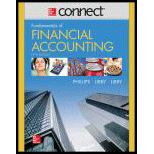
Concept explainers
To prepare: The
Explanation of Solution
Journal:
Journal is the book of original entry. Journal consists of the day today financial transactions in a chronological order. The journal has two aspects; they are debit aspect and the credit aspect.
The accounting equation implies the relationship between the assets, liabilities, and the stockholders equity. The balance of both the assets and the liabilities, stockholders equity must be equally balanced. The accounting equation is as follows;
- a. To journalize: The issuance of common stock.
| Date | Account Title and Explanation | Debit ($) | Credit ($) |
| Cash (A+) | 80,000 | ||
| Common stock (SE+) | 80,000 | ||
| (To record the issuance of common stock to investors) |
Table (1)
- Cash is an asset account. Thus, an increase in cash increases the asset account. Hence, debit cash account by $80,000.
- Common stock is a component of
stockholder equity account. Thus, an increase in common stock increases the stockholders equity account. Hence, common stock account is being credited to increase its balance by $80,000.b. To journalize: The service rendered partly for cash and partly on account.
| Date | Account Title and Explanation | Debit ($) | Credit ($) |
| Cash (A+) | 16,000 | ||
| Accounts receivable (A+) | 72,000 | ||
| Service revenue (R+, SE+) | 88,000 | ||
| (To record the service performed partly for cash and partly on account) |
Table (2)
- Cash is an asset account. Thus, an increase in cash increases the asset account. Hence, debit cash account by $16,000.
- Accounts receivable is an asset account. Thus, an increase in accounts receivable increases the asset account. Hence, debit accounts receivable account by $72,000.
- Service revenue is a stockholder’s equity account. Thus, an increase in service revenue increases the stockholder’s equity account. Hence, service revenue account is being credited to increase its balance by $88,000.
- c. To journalize: The equipment purchased on account.
| Date | Account Title and Explanation | Debit ($) | Credit ($) |
| Equipment (A+) | 82,000 | ||
| Accounts payable (L+) | 82,000 | ||
| (To record the purchase of equipment on account ) |
Table (3)
- Equipment is an asset account. Thus, an increase in equipment increases the asset account. Hence, debit equipment account by $82,000.
- Accounts payable is a liability account. Thus, an increase in accounts payable increases the liability account. Hence, account payable account is being credited to increase its balance by $82,000.
- d. To journalize: The repair expense incurred on account.
| Date | Account Title and Explanation | Debit ($) | Credit ($) |
| Repairs and maintenance expenses (E+, SE-) | 3,000 | ||
| Accounts payable (L+) | 3,000 | ||
| (To record the repair expenses incurred on account) |
Table (4)
- Repairs and maintenance is an expense account which comes under
Retained earnings in stockholder’s equity. Thus, an increase in Repairs and maintenance expense account decreases the stockholder’s equity account. Hence, Repairs and maintenance expenses account is being debited to increase its balance by $3,000. - Accounts payable is a liability account. Thus, an increase in accounts payable increases the liability account. Hence, accounts payable account is being credited to increase its balance by $3,000.
- e. To journalize: The cash received for the service rendered on account.
| Date | Account Title and Explanation | Debit ($) | Credit ($) |
| Cash (A+) | 65,000 | ||
| Accounts receivable (A–) | 65,000 | ||
| (To record the cash received for the service performed on account) |
Table (5)
- Cash is an asset account. Thus, an increase in cash increases the asset account. Hence, debit cash account by $65,000.
- Accounts receivable is an asset account. Thus, a decrease in accounts receivable decreases the asset account. Hence, debit accounts receivable account by $65,000.
- f. To journalize: The amount borrowed by signing a note.
| Date | Account Title and Explanation | Debit ($) | Credit ($) |
| Cash (A+) | 90,000 | ||
| Notes payable (L+) | 90,000 | ||
| (To record the amount borrowed by signing a note) |
Table (6)
- Cash is an asset account. Thus, an increase in cash increases the asset account. Hence, debit cash account by $90,000.
- Notes payable is a liability account. Thus, an increase in notes payable increases the liability account. Hence, notes payable account is being credited to increase its balance by $90,000.
- g. To journalize: The rent paid in advance.
| Date | Account Title and Explanation | Debit ($) | Credit ($) |
| Prepaid Rent(A+) | 74,400 | ||
| Cash (A-) | 74,400 | ||
| (To record the rent amount paid in advance ) |
Table (7)
- Prepaid rent is an asset account. Thus, an increase in prepaid rent increases the asset account. Hence, debit prepaid rent account by $74,400.
- Cash is an asset account. Thus, a decrease in cash decreases the asset account. Hence, credit cash account by $74,400.
- h. To journalize: The wages expense incurred for the current month.
| Date | Account Title and Explanation | Debit ($) | Credit ($) |
| Salaries and Wages expenses (E+, SE–) | 38,000 | ||
| Cash (A–) | 38,000 | ||
| (To record the payment of wages to employees) |
Table (8)
- Salaries and Wages expense is a component of stockholder equity account. Thus, an increase in Salaries and Wages expenses decreases the stockholders equity account. Hence, Salaries and Wages expenses account is being debited to increase its balance by $38,000.
- Cash is an asset account. Thus, a decrease in cash decreases the asset account. Hence, credit cash account by $38,000.
- i. To journalize: The delivery expense incurred.
| Date | Account Title and Explanation | Debit ($) | Credit ($) |
| Delivery expenses (E+, SE–) | 49,000 | ||
| Cash (A–) | 49,000 | ||
| (To record the delivery expenses incurred) |
Table (9)
- A delivery expense is a component of stockholder equity account. Thus, an increase in delivery expenses decreases the stockholders equity account. Hence, delivery expenses account is being debited to increase its balance by $1,200.
- Cash is an asset account. Thus, a decrease in cash decreases the asset account. Hence, credit cash account by $1,200.
- j. To journalize: The payment made for the purchase of furniture on account.
| Date | Account Title and Explanation | Debit ($) | Credit ($) |
| Accounts payable (L-) | 2,000 | ||
| Cash (A-) | 2,000 | ||
| (To record the payment made for the accounts payable) |
Table (10)
- Accounts payable is a liability account. Thus, a decrease in accounts payable decreases the liability account. Hence, account payable account is being debited to decrease its balance by $15,000.
- Cash is an asset account. Thus, a decrease in cash account decreases the asset account. Hence, cash account is being credited to decrease its balance by $15,000.
- k. No entry is required for this item, as there is no exchange transaction has ocuured.
Want to see more full solutions like this?
Chapter 3 Solutions
Connect 1 Semester Access Card for Fundamentals of Financial Accounting
- I am looking for the correct answer to this general accounting problem using valid accounting standards.arrow_forwardA company paid $36,000 for a 3-year insurance policy on January 1, 2024. The payment was recorded as a prepaid expense. What is the adjusting entry required on December 31, 2024?arrow_forwardThe financial statements of the Patterson Industries reported net sales of $875,000 and accounts receivable of $95,000 and $65,000 at the beginning of the year and end of the year, respectively. What is the receivables turnover ratio for Patterson?arrow_forward
- I am looking for the correct answer to this general accounting question with appropriate explanations.arrow_forwardElmont Industries issues $2,400,000 of 8% bonds at 101. What is the amount of cash Elmont would receive from the sale? A. $2,373,000 B. $2,240,000 C. $2,424,000 D. $2,185,000 E. None of the abovearrow_forwardPlease give me true answer this financial accounting questionarrow_forward
- In August, Evergreen Hospitality Group incurred $75,000 of food service costs and served 15,000 meals.arrow_forwardI need help finding the accurate solution to this general accounting problem with valid methods.arrow_forwardPlease provide the solution to this general accounting question using proper accounting principles.arrow_forward
 Financial AccountingAccountingISBN:9781337272124Author:Carl Warren, James M. Reeve, Jonathan DuchacPublisher:Cengage Learning
Financial AccountingAccountingISBN:9781337272124Author:Carl Warren, James M. Reeve, Jonathan DuchacPublisher:Cengage Learning Managerial Accounting: The Cornerstone of Busines...AccountingISBN:9781337115773Author:Maryanne M. Mowen, Don R. Hansen, Dan L. HeitgerPublisher:Cengage Learning
Managerial Accounting: The Cornerstone of Busines...AccountingISBN:9781337115773Author:Maryanne M. Mowen, Don R. Hansen, Dan L. HeitgerPublisher:Cengage Learning Intermediate Accounting: Reporting And AnalysisAccountingISBN:9781337788281Author:James M. Wahlen, Jefferson P. Jones, Donald PagachPublisher:Cengage Learning
Intermediate Accounting: Reporting And AnalysisAccountingISBN:9781337788281Author:James M. Wahlen, Jefferson P. Jones, Donald PagachPublisher:Cengage Learning


